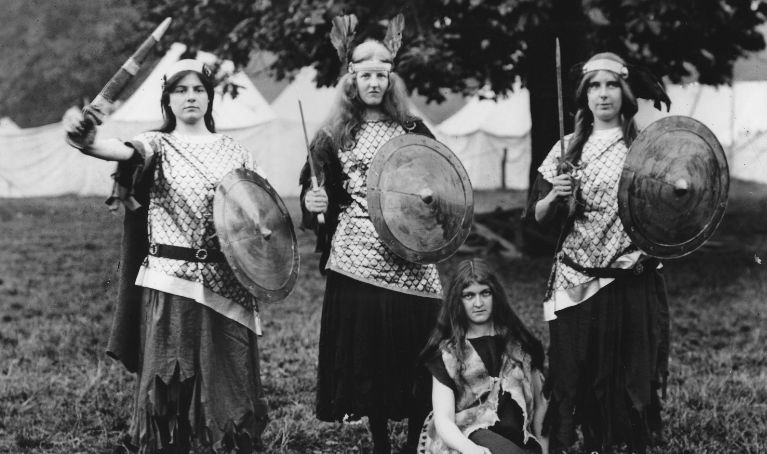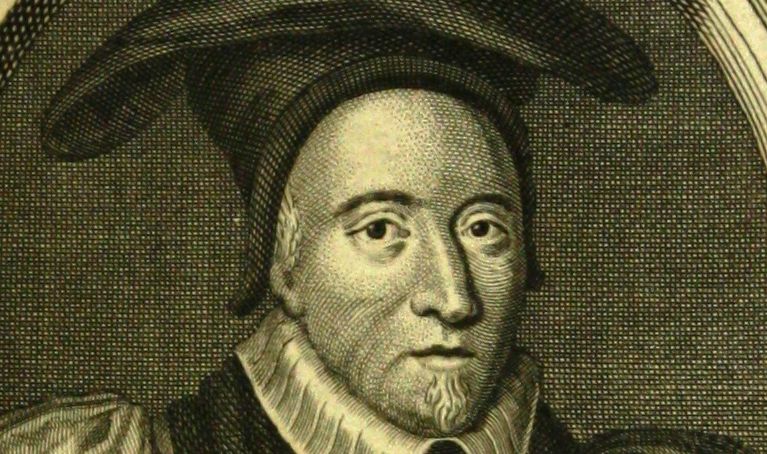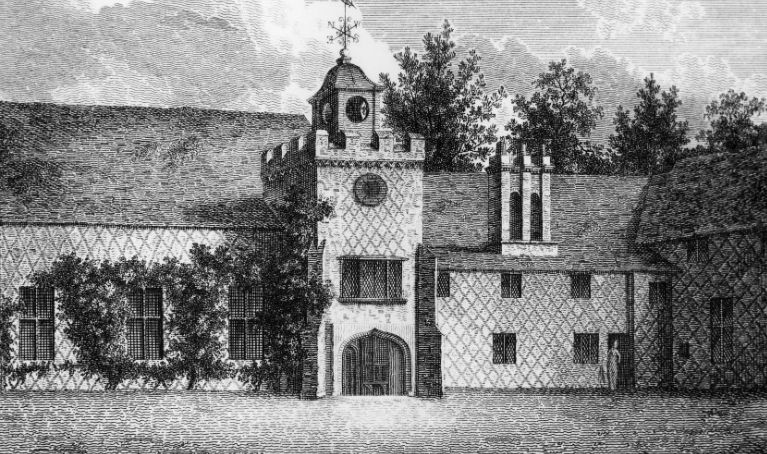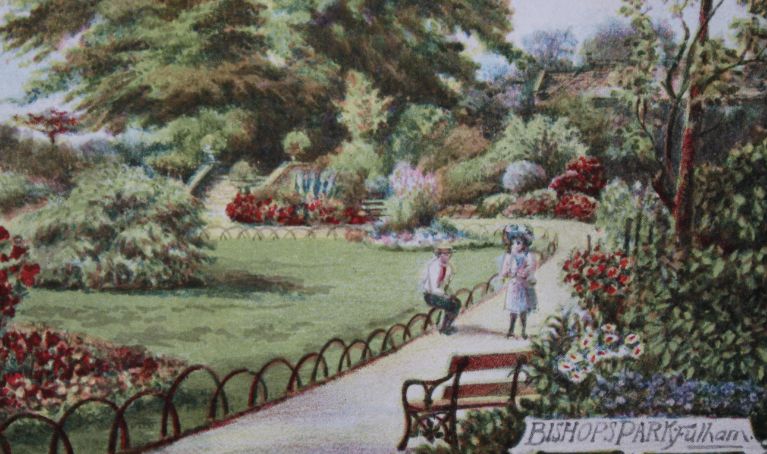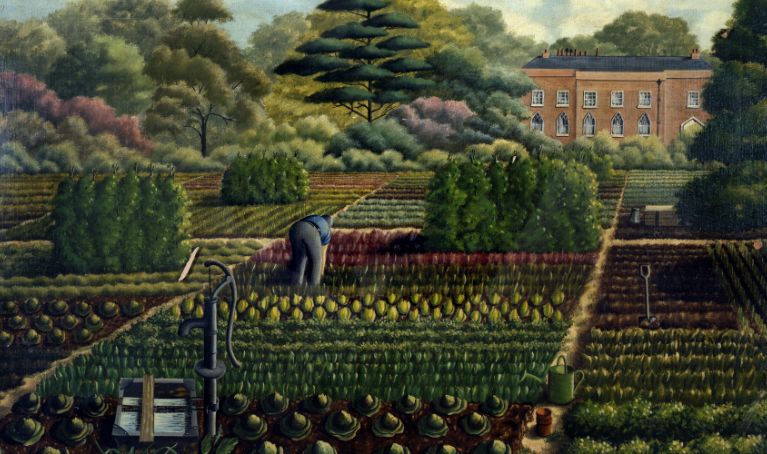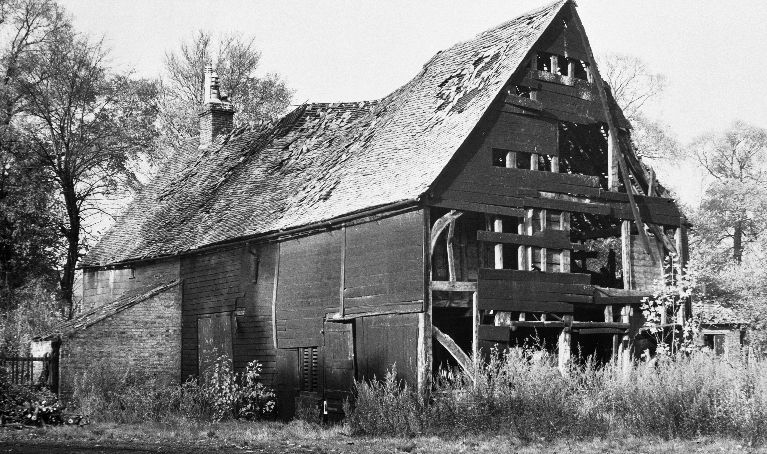Timeline
Prehistoric to present day – the story of Fulham Palace is a long, eventful and revealing journey. One we’re still unraveling through our archaeological investigations and continued research.
-
4,000 BC
Archaeological finds, like this polished axe, indicate Late Mesolithic, Early Neolithic travellers crossed the Fulham Palace site, most likely because of its location next to a natural point to cross the River Thames.
![late mesolithic, early neolithic polished stone axe]()
-
2,500 to 700 BC
During the Bronze Age Fulham was farmland. A recently discovered ring ditch indicates the possible site of a low barrow on the Fulham Palace site.
![two archaeologists examining the bronze age ring ditch]()
-
AD 200 to 410
Our archaeological investigations have uncovered many Roman artefacts, including coins, pottery and building materials, indicating that a Roman villa once stood close to our walled garden.
![a roman arcadius coin]()
-
AD 400 to 600
Although evidence of Anglo-Saxon settlements are rare in London, two sherds of early Saxon pottery were discovered at Fulham Palace, indicating the possible occupation of the site during this period.
![a small sherd of saxon pottery]()
-
AD 704
Bishop Waldhere acquired the Manor of Fulham from the Bishop of Hereford. It was a vast estate covering most of Hammersmith, Fulham, Acton, Ealing and Finchley. That same year he wrote a letter which is now the oldest surviving letter on parchment in Western Europe.
![Parchment letter written by bishop waldhere in AD 704 © British Library]()
-
AD 878
According to the Anglo Saxon Chronicle records, there was a Viking encampment on the Fulham Palace site for between one and two years before they departed to Gent.
![women dressed as viking warriors for 1909 church pageant]()
-
Between 1066 and 1485
36 acres of the estate was enclosed by a moat, creating the longest domestic moat in England.
![an old coloured map showing the palace site surrounded by the moat]()
-
Around 1231
The Palace once had a medieval chapel, built in the early 13th century and first mentioned in 1231. It was demolished in August 1764, but during hot summers you can still see the outline of where it stood. Keep an eye out for the parchmarks just outside the cafe.
![]()
-
Between 1480 and 1550
One of the earliest turkeys in Britain was eaten at Fulham Palace. The bones were discovered during a recent archaeology dig of a medieval ditch. Gobble gobble!
![painting of a turkey by Majorat of Setbal]()
-
Around 1495
The Tudor courtyard and great hall were built. Dendro-chronological analysis of the timbers in the courtyard gate and great hall roof indicate the trees were cut down between 1493 and 1495.
![the timber front gates of the tudor courtyard]()
-
1547
During the English Reformation, Church of England clergy were granted the right to marry. The first Bishop's wife arrived in 1570, and Fulham Palace became a family home.
![a tudor bishop and his wife sitting side by side]()
-
1553 to 1559
During Bishop Bonner's second tenure as Bishop of London under the Catholic Queen Mary I, he kept prisoners at Fulham Palace and tortured Protestants in the great hall.
![etiching of bishop bonner holding mans hand over a candle]()
-
1555
Bishop Ridley didn't support Henry VIII's daughters', Mary and Elizabeth, claim to the throne and called them illegitimate. When Mary become Queen Mary I, Bishop Ridley was burned at the stake for heresy.
![etching of bishop ridley being burned at the stake]()
-
1600
Queen Elizabeth I visited Fulham Palace and the Bishop prepared a lavish banquet in her honour. Two thieves stole her silver salt cellar. They were caught and the cellar returned. There's no mention of what happened to the thieves...
![A watercolour of queen elizabeth the first]()
-
1646
During the English Civil War, Parliament abolished bishops and Bishop Juxon was expelled from the estate. Three years later Bishop Juxon accompanied King Charles I to his execution, offering the King his last rites.
![etching of bishop william juxon]()
-
1647
The Fulham Palace estate was sold to Colonel Edmund Harvey for £7,617 2s 6d. After the restoration of the monarchy in 1660, the estate was restored to the Bishops of London.
![etching of the tudor courtyard]()
-
1683 and 1688
Bishop Compton received shipments of plant cuttings and seeds from North America. He successfully grew thousands of exotic plants from around the world at Fulham Palace.
![a botanica print of swamp azalea rhododendron viscosum]()
-
1750s
Bishop Sherlock built an elaborately decorated dining room in the rococo style, and covered the original timber roof of the great hall with a false ceiling.
![close up of face in bishop sherlocks dining room plaster ceiling]()
-
1760s
Bishop Terrick remodelled the house in the Gothic Revival style, adding crenellation along the top of the building. He also relandscaped the garden and created the walled garden.
![hand coloured etching of the palace and a boat on the river thames]()
-
1770
The clock was added to bell tower in the Tudor courtyard. The bell itself is 100 years older, commissioned by Bishop Compton from the the Whitechapel Bell Foundry, who also made Big Ben.
![tudor courtyard clock tower on a grey day]()
-
1813 to 1828
Bishop Howley, not a fan of Gothic Revival, remodelled the house in the Georgian style. He also built the first pinery vinery in the walled garden.
![the georgian face of the palace on a sunny day]()
-
1867
The chapel was designed by William Butterfield for Bishop Tait. The Salviati mosaic reredos depicting the Nativity was moved to the west wall after the chapel was remodelled due to bomb damage in World War II.
![close up of the face of the wise man from the salviati nativity mosaic]()
-
1893
Bishop's Park opened to the public. The park was created using land donated by the Bishop of London under the condition that it is used and maintained for public recreation.
![watercolour of two children playing in bishops park]()
-
1916
Bishop Winnington-Ingram donated the meadow to the north of the Palace to be used as allotments during the World War I 'Dig for Victory' campaign.
![painting of the fulham palace meadow allotments]()
-
1918 to 1919
Fulham Palace was used as an auxiliary military hospital for wounded soldiers during World War I. Freemasons War Hospital No. 2, run by the British Red Cross, had 100 beds.
![picture of patients in beds and nurses at the first world war hospital at fulham palace]()
-
1921
Bishop Winninton-Ingram decided to drain and fill in the moat. The decision led to such a public outcry that the issue was raised in the Houses of Parliament. He went ahead with it anyway.
![man and child sit beside the moat with all saints church in the distance]()
-
1939 to 1945
During World War II, a barrage balloon was flown above the site to deter enemy planes flying too low. Members of the the Women's Auxiliary Air Force (WAAF) were stationed at Fulham Palace to look after the balloon.
![photograph of three world war two waafs standing outside]()
-
1952
The 17th century tithe barn was demolished and a new gardener's cottage was built on the site.
![photograph of 17th century tithe barn in disrepair]()
-
1973
Bishop Stopford was the last Bishop to live at Fulham Palace. The Bishop of London now lives at The Old Deanery near St Paul's Cathedral.
![photograph of bishop stopford in the tudor courtyard]()
-
1975
Fulham Palace was leased for 100 years by the London Borough of Hammersmith and Fulham. The garden was open to the public, and the house used for office space and events. The council undertook two phases of restoration, completed in 2006 and 2011.
![Bishop Sherlock's coat of arms above doorway in restored dining room]()
-
2011
Fulham Palace Trust was formed and took over the running of the site. The Trust has recently undertaken a third phase of restoration, restoring the Tudor courtyard and historic rooms, creating a new museum and expanded the collection of historically significant plants in the garden.
![tudor courtyard on a sunny day]()





